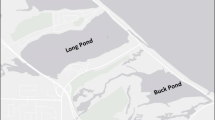Summary
The locomotor response of juvenileGinglymostoma cirratum, the nurse shark, to six covert, discrete sources of an attractant chemical stimulus (fresh shrimp extract) was monitored in a tank (5×5×0.5 m) by means of a square matrix of 1936 photocells embedded in the floor and an on line computer. The experiments were done in flowing (1.17 cm/s) and stagnant water in order to determine the effects of flow on the accuracy of localization and to clarify some of the locomotor mechanisms involved. The response was quantified by a temporal and spatial analysis of activity, distance travelled, mean velocity, mean turn size, step length between turns and its direction vector, frequency of turning, the time spent by the animal in the quadrants of the tank, the mean direction vector of the steps and computer plots of locomotor pathways. For controls, the locomotion was monitored in the absence of chemical stimulation and with a placebo (seawater) replacing the shrimp extract. Five animals were used in 22 experiments in flowing, 20 in stagnant water. The relationship between each of the above-mentioned locomotor variables and the position of the discrete source of stimulation was examined by regression analyses and compared quantitatively between flowing and stagnant water. Localization is very precise in flowing water and is dependent on the gradient of the stimulus in the medium. Downstream sites of stimulation are better localized than upstream ones. In stagnant water only generalized localization occurs. The flowing water provides the direction vector for precise localization.
Similar content being viewed by others
References
Eibl-Eibesfeldt, I., Hass, H.: Erfahrungen mit Haien. Z. Tierpsychol.16, 733–746 (1959)
Hobson, E. S.: Feeding behavior in three species of sharks. Pacific Sci.17, 171–194 (1963)
Kleerekoper, H.: The response to amine “F” by six species of marine fish. (Abstr.) Amer. Zoologist3, 169 (1963)
Kleerekoper, H.: Olfaction and orientation in fishes. (Abstr.) Amer. Zoologist5, 382 (1965)
Kleerekoper, H.: Some aspects of olfaction in fishes with special reference to orientation. Amer. Zoologist7, 385–395 (1967)
Kleerekoper, H.: Some effects of olfactory stimulation on locomotor patterns in fish. In: Olfaction and taste, p. 625–645, T. Hayashi ed. Proc. 2nd International Symp. 1965. Oxford: Pergamon Press 1967
Kleerekoper, H.: Olfaction in fishes. Bloomington-London: Indiana University Press 1969
Kleerekoper, H.: Locomotor responses to environmental variables by sharks and teleosts. In: Physiological adaptation to the environment. Proc. of AIBS Symp., Amherst, Mass. 1973. New York: Intext Educational Publishers (in press)
Kleerekoper, H., Westlake, G. F., Matis, J. H., Gensler, P. J.: Orientation of goldfish (Carassius auratus) in response to a shallow gradient of a sublethal concentration of copper in an open field. J. Fish. Res. Bd. Canada29, 45–54 (1972)
Kleerekoper, H., Timms, A. M., Westlake, G. F., Davy, F. B., Malar, T., Anderson, V. M.: An analysis of locomotor behavior of goldfish (Carassius auratus). Anim. Behav.18, 317–330 (1970)
Mathewson, R. F., Hodgson, E. S.: Klinotaxis and rheotaxis in orientation of sharks toward chemical stimuli. Comp. Biochem. Physiol.42A, 79–84 (1972)
Matis, J., Kleerekoper, H., Childers, D.: On forecasting the locomotor behavior of the nurse shark,Ginglymostoma cirratum. J. interdisciplin. Cycle Res. (in press)
Matis, J., Kleerekoper, H., Gensler, P.: A time series analysis of some aspects of locomotor behavior of goldfish,Carassius auratus L. J. interdisciplin. Cycle Res.4, 145–158 (1973)
Matis, J., Kleerekoper, H., Gruber, D.: The locomotor behavior of the nurse shark,Ginglymostoma cirratum; a time series analysis. Acta Biotheoretica (in press)
Parker, G. H.: Olfactory reactions in fishes. J. exp. Zool.8, 535–542 (1910)
Parker, G. H., Sheldon, R. E.: The sense of smell in fishes. Bull. Bur. Fisheries82, 33–46 (1913)
Pavlov, D. S.: Some data on sense of smell of nalima (Gaidropsarus mediterraneus L.) and its significance in searching for food. Vopr. Ikhtiol.2, 361–366 (1962)
Sheldon, Ralph E.: The sense of smell in selachians. J. exp. Zool.10, 51–62 (1911)
Teichmann, H., Teichmann, R.: Untersuchungen über den Geruchssinn der Haifische. Pubbl. Staz. Zool. Napoli31, 76–81 (1959)
Tester, A. L.: The role of olfaction in shark predation. Pacific Sci.17, 145–170 (1963)
Zar, J. H.: Biostatistical analysis. Englewood Cliffs, N. J.: Prentice-Hall 1974
Author information
Authors and Affiliations
Additional information
This research is part of a more extensive investigation of orientation mechanisms in sharks and is supported by the Office of Naval Research, U. S. Department of the Navy, under grant no. N00014-68-A-0308-0005 to H. Kleerekoper.
Rights and permissions
About this article
Cite this article
Kleerekoper, H., Gruber, D. & Matis, J. Accuracy of localization of a chemical stimulus in flowing and stagnant water by the nurse shark,Ginglymostoma cirratum . J. Comp. Physiol. 98, 257–275 (1975). https://doi.org/10.1007/BF00656973
Received:
Issue Date:
DOI: https://doi.org/10.1007/BF00656973




